Thinking through Complexity, Managing for Uncertainty
ETHOS Issue 07, Jan 2010

INTRODUCTION
Recent events suggest that we are experiencing a period of increased "turbulence": take for example, the wide-ranging impact of the South-east Asian Tsunami in 2004, the September 11, 2001 incident, the 1998 Asian Financial Crisis, the 2003 Severe Acute Respiratory Syndrome (SARS) epidemic and the 2008 Financial Crisis. Many organisations are asking why these severe crises were not detected sufficiently early by their risk management systems.
One reason is that the world is becoming more complex and therefore, more unpredictable.
The second reason is that current risk management systems and other attempts to predict the future are based too much upon linear relationships derived from past experience. They fail to take into account our behavioural limitations in handling probabilities, and also the nature of complex non-linear systems which do not always have a definite or repeatable cause and effect relationship. We need, therefore, to consider a new way of looking at the world around us and a new way of thinking about issues instead of the traditional "Rational Man" model.
Combining the findings from Behavioural Economics and Complex Systems points of view, we can classify the way we think and manage events in a two-by-two matrix as follows:
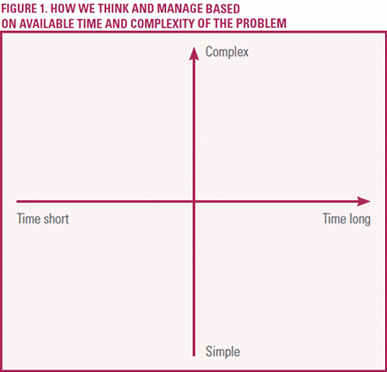
Behavioural economists have shown that when confronted with decisions in a short time interval, we think in ways that are different than if we were given more time to make decisions. We use the Automatic System to deal with matters that require very fast decisions. The Automatic System, as the name suggests, controls our intuitive, automatic responses. It is typically uncontrolled, effortless, associate, fast, unconscious and based on practised skills. This is the system of thinking we tend to use in our day-to-day activities, and when we have only a short time in which to make decisions.1
Current risk management systems and other attempts to predict the future are based too much upon linear relationships derived from past experience.
When adequate time is available for reflection, we use the Reflective System. This mode of thinking is controlled, effortful, deductive, slow, self-aware and rule-following. Most of what we are taught in schools, our reasoning and analysis and the rational method are based on the Reflective System. In particular, the great advances in science and technology can be attributed to the use of the rational method. Most economic analysis now is based on the so-called "Rational Man Model". This rational method has served us well so far, but may no longer be sufficient in solving some complex problems.
THE EMERGENCE OF COMPLEXITY
It used to be thought that if we could just collect enough data, if we had enough computing power, we could model any system, such as the weather or the economy. Complexity theory has demonstrated that non-linear effects, when amplified over a sufficiently long period of time, can upset all our predictions. The weather and the economy are examples of complex systems. Such systems exhibit regularity in behaviour without being completely predictable. They are therefore capable of creating entirely unexpected new forms of behaviour. In other words, the relationship between cause and effect in complex systems is not as consistent as the regular, predictable simple systems we are familiar in dealing with.
DIFFERENT MANAGEMENT STYLES FOR DIFFERENT CONTEXTS
Combining these two dimensions gives us the following matrix to classify the mode of thinking appropriate for different situations.
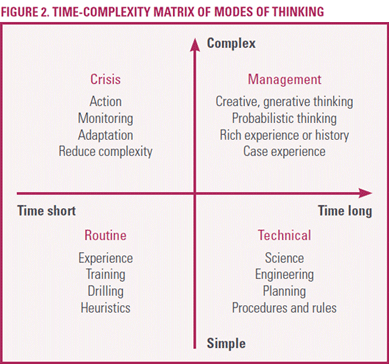
In the Routine quadrant, where time is short and the task is simple, we rely upon past experience, learned heuristics, and rules of thumb. Skill in this area can be gained through training and drilling, and the creation of rules or protocols.
In the Technical quadrant, there is time for planning ahead and using elaborate analysis relying on acquired codified knowledge. There is no need to reinvent the wheel because there are clear cause-effect relationships here that allow us to project ahead quite precisely based upon previously discovered "laws", such as mathematical rules or scientific formulae. Much of conventional education is focused on the acquisition of competencies necessary to operate in this quadrant.
In the Management quadrant, we are concerned with subjects that are complex and lack a clear-cut link between cause and effect. We cannot proceed confidently on the basis of past knowledge to predict the consequences of our actions, nor the evolution of events around us. Rational models are therefore less useful as a guide. We need to be prepared for surprises. Here, the more appropriate strategies are creative thinking, experimenting with new ideas, observing their effects and increasing the probability of outcomes favourable to us.
Finally, in the Crisis quadrant, we are faced with matters that are highly complex, unpredictable and which give us little time to react. This calls for another style of management thinking and intervention aimed at restoring the situation to one that is more manageable: that is, one of the other three quadrants.
Since our interest is how best to operate in a complex and uncertain environment, we will focus our analysis on the Management quadrant.
MANAGING COMPLEXITY IN GOVERNANCE
If we apply this matrix to Singapore, we can describe the issues we faced from the 1960s to the 1980s as falling into a relatively simple set, which can be satisfactorily resolved by the application of the rational method. The characteristic problems of that time were quite straightforward—to build excellent infrastructure, schools and housing, and to create jobs. As Singapore evolves from a third-world to a first-world economy, there is a corresponding rise in the complexity of our problems. Issues such as a declining and ageing population, climate change and rising healthcare costs do not have obvious or straightforward answers. Greater calls for consultation, participation and variation from Singaporeans today can be seen as both symptom and cause of the complexity of our environment. The types of problems can be positioned on the time-complexity matrix as shown in Figure 3.
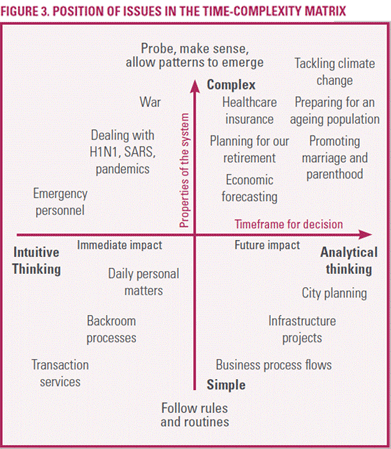
The strength of the Singapore Civil Service is, arguably, in the technical quadrant. Simple environments are generally amenable to what are essentially engineering solutions— solutions which depend on repeatable causes and effects (or at most on probabilistic or stochastic models). The problems of the 1960s to 1980s in Singapore fall into this quadrant.
However, many of our most pressing policy problems now fall in the top right quadrant, in the context of management. Take climate change, for example: governments have to juggle the competing concerns of environmental sustainability, economic competitiveness and national welfare to arrive at the most appropriate policy responses for their country—there are few certainties and no right answers. We have to make sense of the problem by probing, experimenting, creating environments conducive to the generation of new ideas and new interactions, and responding to emerging patterns and behaviours.
Over the last forty years, we have seen a trend of increasing complexity in public issues, and this is reflected in the response in the manner of our public administration as summarised in Figure 4.
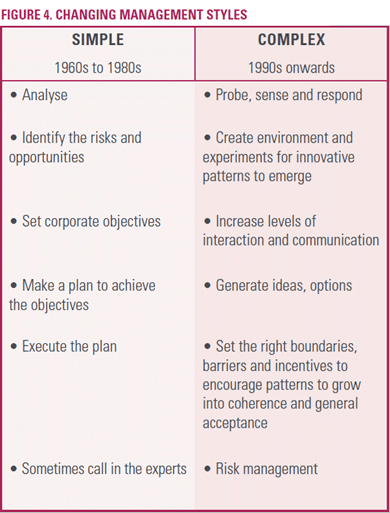
COGNITIVE AND BEHAVIOURAL CHALLENGES
Challenges to thinking exist in all four contexts:
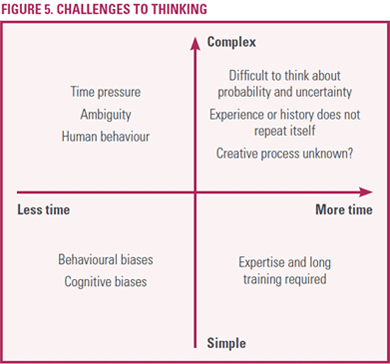
For example, one challenge for managing in an inherently uncertain and complex environment is how we deal with cognitive and behavioural biases. These biases can skew our judgements of probability and uncertainty, especially when we rely on our Automatic System. The following is a short list of the key biases we need to be aware of.
The great rationaliser: Our left brain is the great "rationaliser" or story-teller. Emotions are needed for decision-making, but we often invent stories to explain our decisions to others and ourselves—stories which may vary greatly from our actual deliberations.
Anchoring: Experiments have demonstrated the importance of anchoring effects. For example, if a subject is exposed to a large number just before you make a purchase, he tends to be willing to pay a higher price—even if the number has nothing to do with the object of purchase.
Confronted with decisions in a short time interval, we think in ways that are different than if we were given more time to make decisions.
Confirmation bias: The mind tends to see what it wants to see, which means we often, perhaps unconsciously, ignore evidence that contradicts our beliefs.
Framing effects: How problems or options are framed can have different effects on people's responses. This is especially important to policymaking—for policymakers to avoid being misled by framing effects, and to frame problems carefully to elicit the desired responses in their target audience.2
CONCLUSION
Our education system has done a wonderful job in teaching the analytical thinking we need for most problem-solving. The new thinking for managing complex systems is relatively new. The first lesson we draw from the arguments above is that in the past, we could rely on analysis and control. In the future, we are looking for innovative solutions, or to generate new ideas. The second lesson is that we must remember the motto of Delphi—"Know Thyself"—when we think about issues. In other words, we need to learn to make sense of the environment in which we operate and recognise its inherent uncertainty and complexity. We need to understand the role that emotions play in our decision-making process.3 We need to recognise the behavioural and cognitive biases we are subject to; the time constraints that we act under, and the system of thinking we rely on. Above all, we need to adopt a model of critical thinking that challenges rules established from prior observation because complex systems do not necessarily have repeatable and enduring cause-and-effect relationships.
NOTES
- Thaler, Richard and Sunstein, Cass. Nudge (USA: Yale University Press, 2008).
- For more detailed discussion of the biases, see Daniel Kahneman and Amos Tversky, "Judgement under Uncertainty: Heuristics and Biases", Science, New Series, Vol. 185, No. 4157 (Sep. 27, 1974), pp. 1124-1131.
- For role of emotions in decision-making, see Morse Gardiner, "Decisions and Desires," Harvard Business Review (January 2006).

